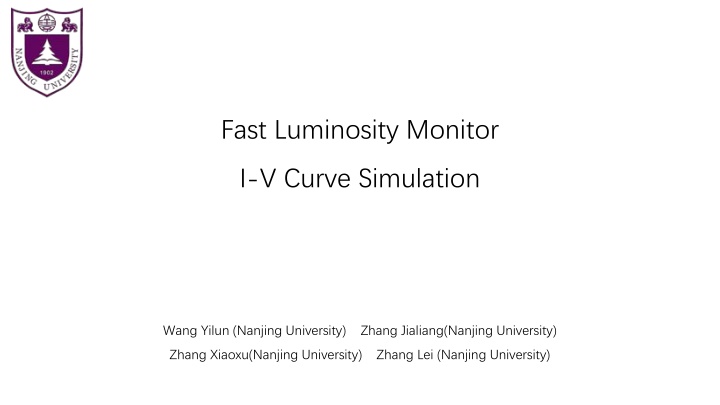
Fast Luminosity Monitor I-V Curve Simulation Details
Discover the intricate details of the Fast Luminosity Monitor I-V Curve Simulation, including the geometry, doping process, and characteristic curves. Explore the innovative design concepts and materials used for high-quality performance in monitoring luminosity at CEPC.
Download Presentation

Please find below an Image/Link to download the presentation.
The content on the website is provided AS IS for your information and personal use only. It may not be sold, licensed, or shared on other websites without obtaining consent from the author. If you encounter any issues during the download, it is possible that the publisher has removed the file from their server.
You are allowed to download the files provided on this website for personal or commercial use, subject to the condition that they are used lawfully. All files are the property of their respective owners.
The content on the website is provided AS IS for your information and personal use only. It may not be sold, licensed, or shared on other websites without obtaining consent from the author.
E N D
Presentation Transcript
Fast Luminosity Monitor I-V Curve Simulation Wang Yilun (Nanjing University) Zhang Jialiang(Nanjing University) Zhang Xiaoxu(Nanjing University) Zhang Lei (Nanjing University)
Contents Introduction Geometry & Doping I-V Characteristic Curve Conclusion
Introduction Fast Luminosity Monitor is used to give bunch luminosity at CEPC Integrated event rates along z-position can help monitoring z-position at IP Polar angle ?~10 ????, highest radiation field at CEPC Detect small angle Bhabha events Electron showers generated in the copper beam pipe Diamond is used for detector Single crystal Chemical Vapor Deposition (sCVD), reducing defect densities High carrier mobility : 2000~2800 ??2? 1? 1 Wide bandgap, low dark noise : 5.47 ?? Strong covalent bonds, high radiation hardness 3 3
Geometry Diamond 10000 10000 500 ?? (x y z) Electrodes Front : 10 eletrodes, each 900 10000 ?? (x y) Back : 1 electrode, 9800 9800 ?? (x y) 3 Layers, 50 nm Ti, 200 nm W, 50 nm Au 4 4
Geometry Contact A small one is used for testing meshing and doping 100 100 500 ?? (x y z) Removed materials between diamond and contact, directly contact to the diamond The properties of contact can be modified for additional 500 ?? studies (Ohmic, Schottky, Resistive...) Meshing refined at regions close to contacts 100 ?? 100 ?? Contact 5 5
Geometry Another design for transient simulation testing later 2000 2000 500 ?? (x y z) Two electrodes on front side, each 900 1900 ?? (? ?) One on back side, 1900 1900 ?? (? ?) 6 6
Doping During CVD process, Boron and Nitrogen are common impurities Doping helps to avoid convergence issues Boron acts as positive-type doping Activation energy 0.37 ?? Add 109,1010, ?? 1011?? 3 to Diamond Material 7 7
I-V Characteristic Curve Quasistationary Simulation Voltage of back electrode : from 0 V to 500 V Physics Models : EffectiveIntrinsicDensity( OldSlotboom ) # doping bandgap narrowing effect Mobility( -ConstantMobility # Do not use ConstantMobility model DopingDep HighFieldsaturation( Eparallel ) Enormal # mobility degradation at interfaces ) Recombination( SRH( DopingDep ) # Shorkley-Read-Hall recombination Avalanche ) 9 9
I-V Characteristic Curve 10 10
I-V Characteristic Curve (Log Y) 11 11
I-V Characteristic Curve Larger x-y area, higher current than previous one 2 Electrodes on front side Half the current Doping : 1011?? 3 Boron 12 12
Conclusion Fast luminosity monitor uses sCVD diamond, for its high carrier mobility, wide bandgap and high radiation hardness The geometry of detector is built, along with 2 smaller designs to calculate I-V characteristic curves and future particle hit simulation Add boron dopant to the diamond detector, with concentrations of 109,1010,1011?? 3 I-V characteristic curves are drawn after quasistationary simulation An order of magnitude higher dopant concentration gives around an order of magnitude higher current at concentrations around 1010?? 3 13 13
